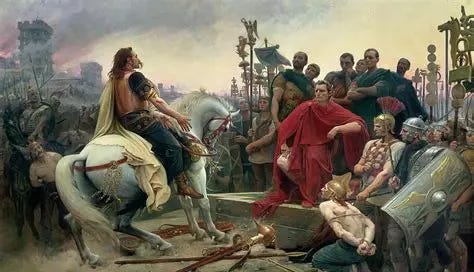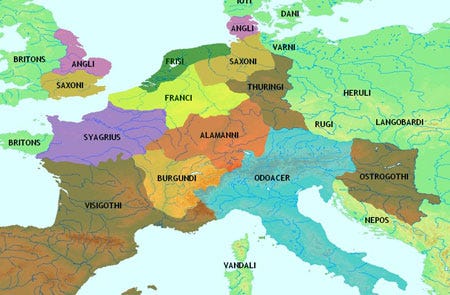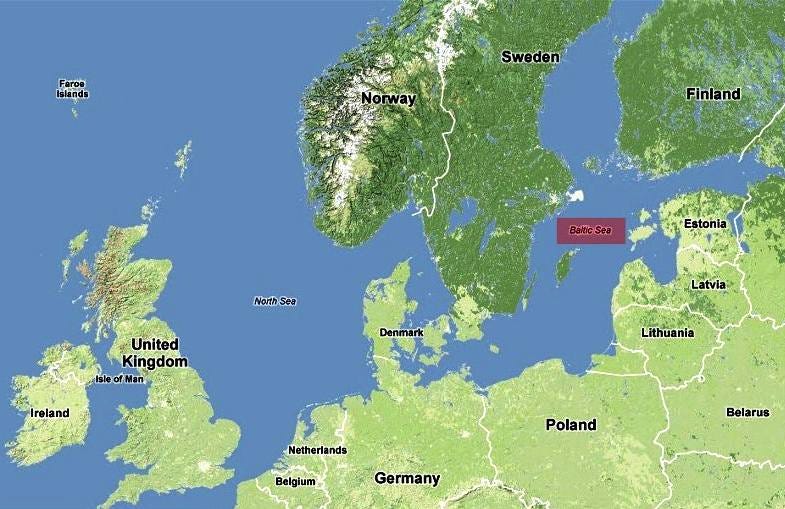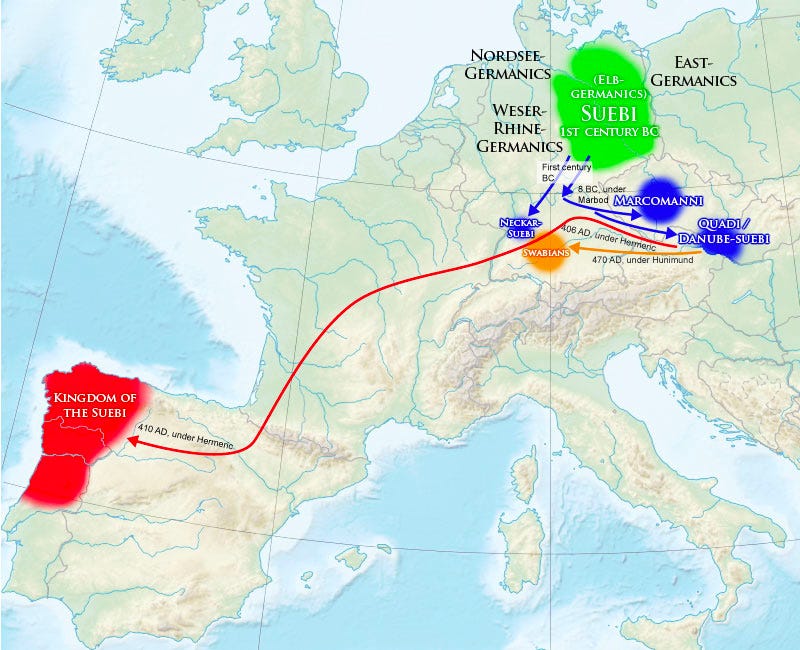Who Were the Germans?
A short historical overview of where the Germans came from, what language they spoke, and what they looked like.
The Primary Sources of Julius Caesar and Tacitus
Before we begin, I want to take a quick look at our primary sources. They mainly come from Julius Caesar and Tacitus. Let’s take a second to see what these two Romans had to say about the Germans and the Germanic Tribes.
Julius Caesar and the Beginning of the Gallic Wars
Historians know a lot about who the ancient Germans were, and yet very little. This paradox is because all of the early sources come from external writers. Julius Caesar is one of the earliest known writers to mention the Germans. Julius Caesar was proconsul in Cisalpine Gaul, Illyrium, and Transalpine Gaul. He was proconsul for five years, but the Gallic Wars lasted for eight. While in Gaul, Julius Caesar decided to expand the territory of Rome by incorporating the rest of Gaul, which Rome did not already control.1 After his wars (58-50 B.C.), he wrote his Commentary on the Gallic Wars. His commentary was written between the end of the Gallic Wars and his assassination in 15 B.C.2
Caesar did not write his book to be as things were, but as things were to him. He was a master politician, and he omitted or changed small details to paint the Romans in a better light. One of the things he did not mention was who the Germans were. What he did say were some minor details that can help us here.
First, Julius Caesar writes that the Germans were courageous and enjoyed fighting. Not much to go on. Fortunately, he goes into more detail later. He writes:
[F]rom childhood they devote themselves to fatigue and hardships. Those who have remained chaste for the longest time, receive the greatest commendation among their people…to have had knowledge of a woman before the twentieth year they reckon among the most disgraceful acts…they do not pay much attention to agriculture, and a large portion of their food consists in milk, cheese, and flesh.
The magistrates and the leading men search year apportion to the tribes and families, who have united together as much land as, and in the place in which, they think proper, and the year after compel them to remove elsewhere… when each sees his own means placed on an equality with those of the most powerful.
When a state either repels war waged against it, or wages it against another, magistrates are chosen to preside over that war with such authority, that they have power of life and death.
To injure guests they regard as impious."3
Based on this account, historians know that the Germans were tough, chaste, nomadic, egalitarian, semi-democratic, and hospitable. Again, this account is only from a man at war with the Germans, though he did ally with some after conquering them. He never spent long periods with them trying to learn their culture. But that is enough with Caesar. Now it is time to move on to someone who was a little less biased.
Tacitus and Germania
The best source after Julius Caesar is Tacitus. He lived a century later, in the first century A.D., and he wrote the book Germania. Historians are not exactly sure when he was born, but based on his writings, most think around 53 A.D. He was born Caius Cornelius Tacitus and lived a prominent life in the Roman Empire. Historians are unsure if he ever visited Germany, but it is possible.4
In his book, historians are told a few different things. First, he mentions that he thought the Germans were indigenous. It is noted that all local groups were believed to be indigenous by the Romans. So not much to go on there. There is a comical comment Tacitus makes about the climate and geography, which was that it was “Rude in its surface, rigorous in its climate, cheerless to every beholder and cultivator, except a native[.]”5 Not everyone could live in the Mediterranean paradise like the Romans.
Tacitus is also where historians are introduced to the god Tuisto, his son Mannus, and the three branches of the Germanic people. Tacitus does not tell us much except that Mannus had three sons named Ingaevones, Hirminones, and Istaevones. He does tell us:
Invaevones would be the father of the Nordic tribes.
Hirminones would be the father of the Eastern tribes.
Istaevones would be the father of the Western tribes.
Later, we will discuss how these three branches are seen in German linguistics.
Tacitus also gives a short account of how the Germans looked. “Eyes stern and blue; ruddy hair; large bodies, powerful in sudden exertions, but impatient of toil and labor[.]”6 Here, the Germans have blue eyes and ruddy hair that can be reddish or blond, and they are tall and muscular and were known to not engage in agriculture much. Primarily, they were hunters and lived a more nomadic life at that time.
Tacitus, writing from a Roman perspective, valued farming like the rest of the Roman aristocracy. Historians are told in the tale of Cincinattus (who was a great Roman general) that the greatest task a man could do was to work on his own farm.7
The last thing Tacitus wrote on was the layout of the Germanic tribes. I won’t go into detail here, since that would take an entire post, or book, on its own. Instead, you can look over the map below and get a general idea of what tribe lived where. Some of these tribes weren’t mentioned in Germania, but for my purposes here, that’s ok.
Where Did They Come From?
The Germans first came from the North Sea. It is believed that they surrounded the North and Baltic Seas, meaning that they came from the southern tip of Norway and Sweden, encompassed Denmark, and the northern section of Germany.8 Beginning somewhere around the 3rd century B.C., Germanic tribes started to migrate from their ancestral home. They went south and west, stopping at the Rhine. The map below shows the Rhine to separate Germania Magna (Greater Germany) and Gaulia.
The Romans did not cross the Rhine much, meaning anything north of it was mysterious. Some northern nations, like Finland, were thought to be islands, and the North Sea was considered a volatile body of water that the Romans did not want to sail on. Most Romans believed Germania to be harsh, cold, and undesirable for any civilized people—a perfect land for the Germans, in their view.
Based on the map below, the Germans slowly migrated from Norway, Sweden, Finland, Estonia, Latvia, Lithuania, Poland, Germany, and Denmark. Naturally, not every German migrated, which is why Scandinavia is still considered a Germanic culture, though distinct from their southern brethren. As time went on, the Rhine became the defining feature for the Germans.
Eventually, by the 3rd century A.D. or so, the Germans started to cross the Rhine to pursue new lands. The main belief for the first and second migrations is overpopulation.9 With the eastern side of the Rhine becoming crowded, more and more Germans moved west. They did so peacefully by settling villages or aggressively by invading the Gauls and the Romans. As the centuries passed, the Germans conquered more and more land. Rome was sacked multiple times (the last being in 476 A.D., signaling the end of the Western Roman Empire).10 Some tribes settled in Denmark, others in Gaul, and others traveled to Spain. The Vandals even migrated to northern Africa for a while.11
So, the migration of the Germanic tribes from the North and Baltic Sea radically changed Europe as it had been known. Many of the Celtic tribes melded with the Germans, and even the Latin inhabitants who had settled there had to adapt to their new neighbors and rulers.
What Languages Did They Speak?
With the Germans migrating, it is time to examine their language. As mentioned above, the ancient Germans can be divided into three groups. Based on the Mannus myth, those three groups were the Ingvaeones, Hirminones, and Istvaeones. More modern linguists call them Northern Germanic, Weser-Rhine Germanic, and Eastern Germanic.
Before they branched, the Germanic languages were believed to be one singular language named Proto-Germanic. By reconstructing words from all three, or mainly two, historians and linguists have hypothesized what the earlier language could have been like. Before Proto-Germanic, it is believed that Proto-Indo-European was the language spoken by all groups that became the different families known today. Indo-European includes German, Latin, Greek, Celtic, Hindi, and many more.
Northern Germanic
The first group hails from the northernmost section of Europe. This form of Germanic, also known as Nordic Germanic, morphed into the modern Scandinavian languages found in Norway, Sweden, Denmark, and the like.
Nordic has three main periods. The first was Ancient Nordic, which would have encompassed the period in this essay. The second was Old Nordic, which ended around the 15th century A.D. And lastly, there is Modern Nordic, which is spoken today.12
Weser-Rhine Germanic
The second sub-group, also called Western Germanic, is found around the Rhine and Weser rivers. The Franks, Saxons, Angles, etc. spoke this form of Germanic. Modern German, English, and other modern nations speak a modernized version of Western Germanic.
Western Germanic has been divided into multiple subcategories, including English, and different periods, such as Old English, Modern English, High German, and Modern German.
Frankish was one of the Medieval Period's most important Western Germanic languages. It was the language of Charlemagne and the form written in some of the Salian Law Codes, which explained Germanic law.
Eastern Germanic
The last branch is not widely spoken today. Some historians believe it actually died out a long time ago.13 Eastern Germanic would have been closest to the Slavic tribes geographically, and might have been swallowed up by them. Groups like the Rus (who became the Russians) spoke Germanic, but now they speak a form of Slavic.14
What Did They Look Like?
It is now time to discuss the Germans' appearance in more depth. As I mentioned before, Tacitus wrote that they had blond or red hair, blue eyes, and were large. But is that true?
Based on studies like those by David Reich, geneticists have found that Europeans, especially those in central and northern Europe, were taller than other ancient peoples.15 In some cases, like the Germans around the first century, they averaged 5’8” to 6’2”.16 In contrast, the average Roman or Jew in the same century was 5’6”, which means that the average German was two inches taller, with some half a foot taller. Tacitus wasn’t kidding when he said they were rugged.
Studies on eye and hair color are much harder to come by. Many geneticists believe that around 7,000 years ago, skin and eye color started shifting in Europe. I cannot find any scientific data supporting Tacitus. I am sure it is out there, but it is out of my reach.
Thank you for reading my article. If you liked what you read, please share, comment, and like it. If you feel generous, you can donate to my Buy Me a Coffee. No matter what you decide to do, I appreciate you stopping by.









